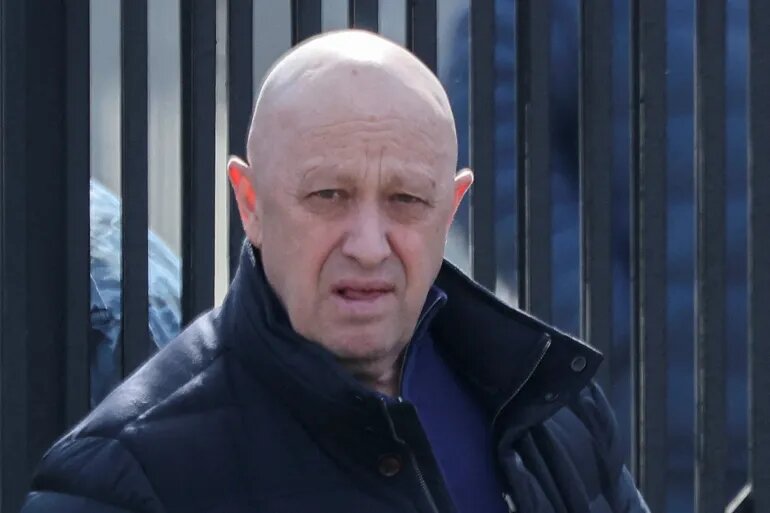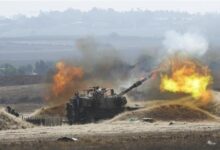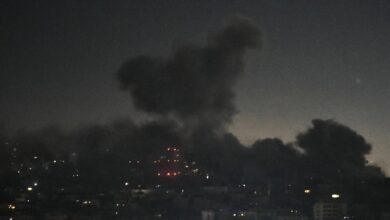Wagner Fighters Approach Russian Nuclear Base During Short-Lived Rebellion

- According to posts on the town's online bulletin board and a video that Reuters said was shot in the town, the convoy's next stop was Buturlinovka.
- According to the Russian Defense Ministry's website and public records, the nuclear facility at Voronezh-45 is run and controlled by military unit number 14254.
On June 24, as rebel Wagner forces headed north toward Moscow, a group of military vehicles went east on a highway toward a fortified Russian army base with nuclear weapons, according to videos shared online and interviews with locals.
Once the Wagner fighters got to more rural areas, the trail of monitoring went cold. This happened about 100 kilometers from the Voronezh-45 nuclear base. Reuters could not confirm what happened next, and Western officials have said many times that Russia’s nuclear stockpile was never in danger during the uprising, which ended quickly and strangely later that day.
But Ukraine’s head of military intelligence, Kyrylo Budanov, said in an exclusive interview that the Wagner fighters went much further. He said that they had reached the nuclear base and that their plan was to get small nuclear devices from the Soviet era so that they could “raise the stakes” in their mutiny. “Because if you are ready to fight until the last man standing, this is one of the places that significantly raises the stakes,” Budanov said.
Budanov said that the only thing stopping the Wagner fighters from getting to nuclear weapons were the doors to the nuclear storage building. He said, “The doors to the storage were locked, and they couldn’t get into the technical part.”
Reuters was not able to independently confirm if Wagner fighters made it to Voronezh-45. Budanov didn’t back up his claim with any proof, and he wouldn’t say whether or not the United States and other allies had talked about the event. He also didn’t say why the fighters ended up leaving.
Parts of Budanov’s story were backed up by a person with military ties who was close to the Kremlin. This person said that a Wagner group “managed to get into a zone of special interest, which made the Americans angry because nuclear weapons are stored there.” This person did not give any more details.
A source in Russian-occupied east Ukraine who knew about the situation said that this caused worry in the Kremlin and gave Belarusian President Alexander Lukashenko a reason to end the rebellion quickly on the evening of June 24.
US leaders said they didn’t believe this story. Adam Hodge, a spokesman for the White House National Security Council, said in answer to a question about whether Wagner forces went to the base and tried to get nuclear weapons, “We are not able to confirm this report. At no point did we know that nuclear weapons or materials were at risk.”
The Kremlin and Yevgeny Prigozhin, who was in charge of the Wagner unit, did not answer questions for this story.
Matt Korda, a Senior Research Associate and Project Manager for the Nuclear Information Project at the Federation of American Scientists, said that it would be “virtually impossible for a non-state actor” to break into Russian nuclear security. He said that Wagner may have had a lot of troops, but it’s rare that any of them knew how to set off a bomb.
“If someone with bad intentions got their hands on a nuclear weapon, they would find it stored in a state where it wasn’t fully put together,” he said. “They would need to be finished by installing specialized equipment and then unlocking permissive action links. To do that, they would need the help of someone from the 12th Directorate,” which is in charge of protecting Russia’s nuclear weapons.
Budanov is the first official to say that Wagner fighters almost got nuclear weapons, which would have made a mutiny that has been seen as the biggest threat to Russian President Vladimir Putin’s power even worse. US leaders have been afraid for a long time that fighting in Russia could lead to nuclear weapons getting into the wrong hands.
Wagner fighters drove in the direction of Voronezh-45 after peeling away from a larger convoy of heavy weaponry that was advancing along the M4 highway that runs north from Rostov, where the uprising started. Residents and social media posts say that this smaller group went east and fought with Russian forces in the first town it reached. But then it seems to have gone 90 km without being stopped, including going through a town with a military base without being stopped.
Reuters followed the group all the way to the Soviet-era town of Talovaya, which is about 100 kilometers from the base. Scientists from the UN wrote in a study that it is one of Russia’s 12 “national-level storage facilities” for nuclear weapons. People from the area who spoke to Reuters said that Russian troops attacked the column at Talovaya. The crew of a Russian chopper was killed when it was shot down.
Budanov was interviewed by Reuters in his office in Kyiv, which Russia had attacked as recently as May. Budanov spoke in front of a painting of an owl, which is a symbol of Ukraine’s spy office, holding a bat, which is a symbol of Russia’s military intelligence agency. He was wearing military fatigues and had a black pistol in his belt. He said that Voronezh-45 has small nuclear weapons that can fit into a bag. “This was one of the most important places to store these backpacks,” he said, but he didn’t give any proof. Reuters couldn’t find out if Voronezh-45 is where Budanov’s nuclear charges the size of a backpack are kept.
These small nuclear bombs, which are light enough for one person to carry, are leftovers from the Cold War. American troops trained to parachute from planes with nuclear bombs strapped to their bodies and Soviet troops trained to deploy them behind enemy lines on foot. But as tensions eased in the early 1990s, both countries decided to take them out of their arsenals. They did, but Russia kept some to mine harbors, according to Hans Kristensen, who runs the Nuclear Information Project at the Federation of American Scientists in Washington.
Several former US officials in charge of stopping the spread of nuclear weapons warned that it’s hard to know for sure if the Russians kept their promise to get rid of their nuclear weapons that look like backpacks. “I don’t think the Russians still have them, but I wouldn’t bet my life on it,” said David Jonas, a former general counsel for the US National Nuclear Security Administration, which keeps track of atomic bombs and radioactive materials around the world.
From 1988 to 2022, Amy Woolf worked at the Library of Congress as a nuclear weapons expert for US politicians. She raised questions about how effective nuclear weapons might be, if they still exist. She said, “It’s possible that there’s still some old junk in storage somewhere.” “But it’s almost certain that it doesn’t work.”
Jonas, who guided top Pentagon officials on how to keep weapons from getting into the wrong hands, agreed. He said that these portable weapons need to be maintained and updated, and that they get worse over time. He said that Russia has had a hard time keeping up with its regular troops, let alone its nuclear stockpile.
A FALLING OUT
Wagner was started by Prigozhin and Dmitry Utkin, who used to work for Russia’s GRU military intelligence as a special forces officer. Cast as a private army, Wagner made it possible for Russia to get involved in wars in places like Syria, Libya, and Mali without having to explain itself. US officials also say that Prigozhin’s business ran a factory of social media trolls that messed with the 2016 election for US president. Putin admitted in recent days that the Russian government paid for Wagner. State TV said that the Russian government had given more than 1.7 trillion roubles ($19 billion) to Prigozhin’s businesses.
On June 23, Prigozhin said that the Russian military had fired a rocket at a Wagner camp in Russian-occupied east Ukraine. This was the first shot in his rebellion. Russia said that there was no such plan.
At least six people inside and outside of Russia say that the conflict had been building up for a long time and that it was about money and tensions between rival clans. Prigozhin had been publicly insulting Putin’s top military leaders for months, calling Defense Minister Sergei Shoigu and Chief of the General Staff Valery Gerasimov corrupt and incompetent and blaming them for setbacks in Russia’s war in Ukraine.
For a long time, no one replied to the attacks in public. Shoigu then hit back. On June 10, he told Wagner fighters that they had to sign contracts with his ministry saying that they would join the normal army by the end of the month. Prigozhin did not agree. On June 13, Putin took Shoigu’s side in public. Sources inside and outside of Russia told Reuters that the mutiny started because the state was trying to cut Wagner’s funds.
Wagner’s troops arrived in the southern city of Rostov early on June 24. Rostov is a key command center for Russia’s operations in Ukraine. Wagner took over the base there, and within hours, video showed Prigozhin talking with Russian officers. Around the same time, other groups of Wagner’s troops headed north on the M-4 highway, heading toward Moscow.
Wagner’s fighters didn’t face much opposition.
Five sources, including a Russian security source, three people close to the Kremlin, and a person close to the Russian-installed leadership in eastern Ukraine, say that some Russian units that stood in their way or were told to stop them did nothing. The security source said that two Russian military groups in the southwest of the country were told to fight against Wagner, but they didn’t.
Some Russian units did nothing because they were taken by surprise and were outgunned, the sources said, while others stood by because they thought, until Putin went on television at 10 am (Moscow time) to denounce Prigozhin, that Wagner was acting on the Kremlin’s orders. Some officers didn’t want to move against Wagner, the sources said, because they felt like they were on the same side as the private army and shared Prigozhin’s disappointment with how the top leaders of the Defense Ministry were running the war.
At the Bugayevka border crossing between Ukraine and Russia, pictures posted on June 24 by a Wagner-related Telegram channel showed dozens of unarmed Russian soldiers waiting in line. They had put down their guns, the caption said.
Oleksiy Danilov, Secretary of Ukraine’s National Security and Defense Council, told Reuters that many people in the Russian military were on Prigozhin’s side. “There are so many commanders who agree with Wagner and don’t want to follow Putin,” he said, adding that he knew of 14 Russian generals who backed Prigozhin. Reuters was not able to check his story about the generals on its own.
One part of the Wagner force went up the M-4 highway to the north, toward Moscow. On their way, they passed right by Boguchar, which is a military town where a Russian unit is based. Three people from the town who talked to Reuters said that the military did nothing to stop the Wagner force and that a lot of people in the town, including people in the military, liked the Wagner force.
One woman said of Prigozhin, “Who else should we support? At least he’s a decent person who wasn’t afraid.” Another woman said that Wagner had a lot of support in the town and that many Wagner soldiers are from Boguchar. “They’re all friends,” she told him.
A NUCLEAR DETOUR
As the main Wagner column moved north toward Moscow, a group of military trucks and some pickups and vans driven by civilians turned east. A video of the event is on a news site for the Voronezh area. Reuters geo-located the video to a junction near the town of Pavlovsk. The group that broke away drove through towns and along a road that went through patches of forest and flat fields. The road went around gullies that the Don River’s tributaries had made.
A video shared on a local online message board on June 24 shows a field near the village of Elizavetovka as the sun comes up. In the distance, there was an explosion and gunshots, and a man yelled, “Has a war started?”
Then there was a new round of automatic gunshots, but this time it was closer.
Reuters talked to the man’s neighbor, who said that the Wagner force had been attacked by the Russian troops. At 8:24 a.m., Anna Sandrakova wrote on the same online bulletin board, “Shells are flying, helicopters are flying low, we could hear explosions and automatic gunfire.” Maxim Yantsov, the head of the Pavlovsk district’s local government, said on his Telegram channel that 19 homes were damaged by the shooting near Elizavetovka.
A few hours later, the convoy went through another village called Vorontsovka. It was still going toward the nuclear plant. Two videos on Telegram show more than a dozen vehicles, like armored personnel carriers, tanks, and trucks with machine guns or carrying weapons.
According to posts on the town’s online bulletin board and a video that Reuters said was shot in the town, the convoy’s next stop was Buturlinovka. A military flying base is in Buturlinovka, which is even closer to the nuclear plant.
By Saturday night, people on a VKontakte online community were saying that a military column was in the town of Talovaya, which is 110 kilometers from the military base. A local person gave Reuters a video of a line of military trucks moving through the town’s outskirts.
A second video shot by a local showed a group of at least 75 vehicles on the edge of town. These vehicles included 5 armored personnel carriers, 2 ambulances, and a truck pulling an artillery gun.
A third person said that people in the area helped the Wagner troops by giving them food and drink. It’ . – – – – – – – – – It’ . -… It shot back, and the helicopter fell to the ground. Then there were explosions and a cloud of smoke.
Later, Russian state media showed a video of a wooden cross that had been put up at the spot in Talovaya district where the Ka-52 attack chopper had crashed. Mikhail Vedernikov, the governor of the Pskov region in northwestern Russia, said that the two crew members who died were stationed at a military base in his area. “True to their oath, they did everything to protect our country,” he said in a video address on his Telegram account.
Reuters couldn’t figure out what would happen to the piece next. A resident of Talovaya said that as far as he knew, it didn’t move any further, and the next day, after the peace was announced, the column turned around and went back the way it came.
Budanov said in his interview that an unknown number of fighters did go to Voronezh-45 with the goal of taking portable nuclear weapons from the Soviet era that were kept there.
According to the Russian Defense Ministry’s website and public records, the nuclear facility at Voronezh-45 is run and controlled by military unit number 14254. This unit is part of the defense ministry’s 12th Main Directorate, which is in charge of protecting Russia’s nuclear arsenal. What is kept there is a secret that is kept very safe. Scientists from other countries have found out that Russia has nuclear weapons there, but they don’t admit it in public.
Reuters was not able to find out if the building is where Budanov said the nuclear charges the size of a backpack are kept. But there is proof that the Soviet Union made these kinds of weapons. Alexei Yablokov, a former science advisor to the Russian president, told the US Congress in 1997 that Soviet scientists made nuclear weapons the size of suitcases in the 1970s so that secret spies could use them.
Kristensen, a researcher with the Federation of American Scientists who said that Russia and the US got rid of thousands of suitcase-sized nukes in the 1990s, said that he doesn’t think any Voronezh-45 are still being kept. He said that he thinks, but can’t be sure, that other nuclear weapons are kept at Voronezh-45, which satellite pictures show is in good shape.
Because the 12th Main Directorate runs the site, he said, moving weapons would take time and would probably be picked up by US satellites.
Further north, there is proof that the Russian military took extreme steps to block off another possible route to Voronezh-45. At a town called Rogachevka, the E-38 road splits off from the M-4 highway. This road goes to Voronezh-45, as well. On the night of June 24, people in the area said they heard blasts.
On a video that was shared to a Telegram channel, you can hear an airplane and then an explosion. A driver on the E-38 shared a video showing debris on the road near a bridge over the Bityug river. There is a deep hole in one lane.
A DEAL IS STRUCK
On the evening of June 24, Belarusian state media made an announcement that came as a surprise. Alexander Lukashenko, the country’s president, had talked with Prigozhin about stopping his troops from moving forward.
Under the deal, Russia would not go after the rebels, and Wagner fighters would either go back to Belarus or join Russia’s normal army.
A European intelligence source said that Prigozhin gave up his revolt when he realized that he didn’t have enough backing in the military.
No one knows where Prigozhin is or what he wants to do next.
Dmitry Peskov, a spokesman for the Kremlin, said Monday that Putin met with the Wagner leader on June 29 and “talked about how he saw the events of June 24.”
Flight tracking data shows that one of Prigozhin’s private jets has made more than one trip between Belarus and Russia in the days since the uprising.
On July 6, when the president of Belarus, Lukashenko, met with a group of journalists in Minsk, he said that Wagner’s troops had not yet arrived at their new base in Belarus. Lukashenko said, “Yevgeny Prigozhin is in St. Petersburg. Or maybe he flew to Moscow this morning. Or maybe he’s somewhere else. But he’s not in Belarus.”







Facebook Comments